Affecting of Nature and Human Activities on the Trend of Vegetation Health Indices in Dak Nong Province, Vietnam
Abstract
1. Introduction
2. Data and Methods
2.1. Data
2.2. Methods
- Re-sample and determine NDVI and LST monthly;
- VCI calculation;
- TCI calculation;
- Trend of the VHIs;
- Raster data of the independent variables;
- Logistic regression;
- Discriminant Analysis.
3. Results and Discussion
3.1. VHIs’ Trend
3.2. Determine the Role of Land Use and Soil in the VHIs’ Trend by Logistic Regression Analysis
3.2.1. Contribution of Land Use Types or Soil Types to the Trend of VHIs through Logistic Regression Equation
3.2.2. The Role of Land Use on the VHIs’ Trend
3.2.3. The Role of Soil Types on the VHIs’ Trend
3.3. The Role of Influence Factors on the VHIs’ Trend by Discriminant Analysis
3.3.1. Convert Independent Variables to Ratio Scale
3.3.2. The Role of Independent Variables on the VHIs’ Trend through Standardized Coefficients of Discriminant Function
3.3.3. Analysing the Role of Independent Variables on the VHIs’ Trend
- Population density (P_Density);
- Population growth rate;
- Distance from roads;
- Distance from rivers.
3.3.4. Accuracy of Simulation Results According to Predictor Variables
4. Conclusions
Author Contributions
Funding
Institutional Review Board Statement
Informed Consent Statement
Data Availability Statement
Acknowledgments
Conflicts of Interest
References
- Yang, Y.; Wang, S.; Bai, X.; Tan, Q.; Li, Q.; Wu, L.; Tian, S.; Hu, Z.; Li, C.; Deng, Y. Factors Affecting Long-Term Trends in Global NDVI. Forests 2019, 10, 372. [Google Scholar] [CrossRef]
- Cao, M.; Woodward, F.I. Dynamic responses of terrestrial ecosystem carbon cycling to global climate change. Nature 1998, 393, 249–252. [Google Scholar] [CrossRef]
- Liu, X.F.; Zhu, X.F.; Pan, Y.-Z.; Li, Y.Z.; Zhao, A.Z. Spatiotemporal Changes in Vegetation Coverage in China during 1982–2012. Shengtai Xuebao/Acta Ecol. Sin. 2015, 35, 5331–5342. [Google Scholar] [CrossRef]
- Chen, C.; Park, T.; Wang, X.; Piao, S.; Xu, B.; Chaturvedi, R.K.; Fuchs, R.; Brovkin, V.; Ciais, P.; Fensholt, R.; et al. China and India Lead in Greening of the World through Land-Use Management. Nat. Sustain. 2019, 2, 122–129. [Google Scholar] [CrossRef]
- Rehman, A.; Qin, J.; Shafi, S.; Khan, M.S.; Ullah, S.; Ahmad, K.; Rehman, N.U.; Faheem, M. Modelling of Land Use/Cover and LST Variations by Using GIS and Remote Sensing: A Case Study of the Northern Pakhtunkhwa Mountainous Region, Pakistan. Sensors 2022, 22, 4965. [Google Scholar] [CrossRef] [PubMed]
- Müller, D.; Zeller, M. Land Use Dynamics in the Central Highlands of Vietnam: A Spatial Model Combining Village Survey Data with Satellite Imagery Interpretation. Agric. Econ. 2002, 27, 333–354. [Google Scholar] [CrossRef]
- Da Silva Melo, M.R.; Rocha, J.V.; Manabe, V.D.; Lamparelli, R.A.C. Intensity of Land Use Changes in a Sugarcane Expansion Region, Brazil. J. Land Use Sci. 2018, 13, 182–197. [Google Scholar] [CrossRef]
- Tomasella, J.; Silva Pinto Vieira, R.M.; Barbosa, A.A.; Rodriguez, D.A.; de Oliveira Santana, M.; Sestini, M.F. Desertification Trends in the Northeast of Brazil over the Period 2000–2016. Int. J. Appl. Earth Obs. Geoinf. 2018, 73, 197–206. [Google Scholar] [CrossRef]
- Singh, R.P.; Roy, S.; Kogan, F. Vegetation and Temperature Condition Indices from NOAA AVHRR Data for Drought Monitoring over India. Int. J. Remote Sens. 2003, 24, 4393–4402. [Google Scholar] [CrossRef]
- Thao, N.T.T.; Khoi, D.N.; Denis, A.; Van Viet, L.; Wellens, J.; Tychon, B. Early Prediction of Coffee Yield in the Central Highlands of Vietnam Using a Statistical Approach and Satellite Remote Sensing Vegetation Biophysical Variables. Remote Sens. 2022, 14, 2975. [Google Scholar] [CrossRef]
- Kriegler, F.J.; Malila, W.A.; Nalepka, R.F.; Richardson, W. Preprocessing Transformations and Their Effect on Multispectral Recognition. Remote Sens. Environ. 1969, 6, 97–132. [Google Scholar]
- Huang, S.; Tang, L.; Hupy, J.P.; Wang, Y.; Shao, G. A Commentary Review on the Use of Normalized Difference Vegetation Index (NDVI) in the Era of Popular Remote Sensing. J. For. Res. 2021, 32, 1–6. [Google Scholar] [CrossRef]
- Baret, F.; Guyot, G. Potentials and Limits of Vegetation Indices for LAI and APAR Assessment. Remote Sens. Environ. 1991, 35, 161–173. [Google Scholar] [CrossRef]
- Bannari, A.; Morin, D.; Bonn, F.; Huete, A.R. A Review of Vegetation Indices. Remote Sens. Rev. 1995, 13, 95–120. [Google Scholar] [CrossRef]
- Wang, X.; Piao, S.; Ciais, P.; Li, J.; Friedlingstein, P.; Koven, C.; Chen, A. Spring Temperature Change and Its Implication in the Change of Vegetation Growth in North America from 1982 to 2006. Proc. Natl. Acad. Sci. USA 2011, 108, 1240–1245. [Google Scholar] [CrossRef] [PubMed]
- Tucker, C.J.; Pinzon, J.E.; Brown, M.E.; Slayback, D.A.; Pak, E.W.; Mahoney, R.; Vermote, E.F.; El Saleous, N. An Extended AVHRR 8-Km NDVI Dataset Compatible with MODIS and SPOT Vegetation NDVI Data. Int. J. Remote Sens. 2005, 26, 4485–4498. [Google Scholar] [CrossRef]
- Tian, J.; Wang, L.; Li, X.; Gong, H.; Shi, C.; Zhong, R.; Liu, X. Comparison of UAV and WorldView-2 Imagery for Mapping Leaf Area Index of Mangrove Forest. Int. J. Appl. Earth Obs. Geoinf. 2017, 61, 22–31. [Google Scholar] [CrossRef]
- Zhu, X.; Liu, D. Improving Forest Aboveground Biomass Estimation Using Seasonal Landsat NDVI Time-Series. ISPRS J. Photogramm. Remote Sens. 2015, 102, 222–231. [Google Scholar] [CrossRef]
- Pastor-Guzman, J.; Atkinson, P.M.; Dash, J.; Rioja-Nieto, R. Spatiotemporal Variation in Mangrove Chlorophyll Concentration Using Landsat 8. Remote Sens. 2015, 7, 14530–14558. [Google Scholar] [CrossRef]
- Chávez, R.O.; Clevers, J.G.P.W.; Decuyper, M.; de Bruin, S.; Herold, M. 50 Years of Water Extraction in the Pampa Del Tamarugal Basin: Can Prosopis tamarugo Trees Survive in the Hyper-Arid Atacama Desert (Northern Chile)? J. Arid Environ. 2016, 124, 292–303. [Google Scholar] [CrossRef]
- Vicente-Serrano, S.M.; Camarero, J.J.; Olano, J.M.; Martín-Hernández, N.; Peña-Gallardo, M.; Tomás-Burguera, M.; Gazol, A.; Azorin-Molina, C.; Bhuyan, U.; El Kenawy, A. Diverse Relationships between Forest Growth and the Normalized Difference Vegetation Index at a Global Scale. Remote Sens. Environ. 2016, 187, 14–29. [Google Scholar] [CrossRef]
- Shuai, J.; Zhang, Z.; Tao, F.; Shi, P. How ENSO Affects Maize Yields in China: Understanding the Impact Mechanisms Using a Process-Based Crop Model. Int. J. Climatol. 2016, 36, 424–438. [Google Scholar] [CrossRef]
- Baniya, B.; Tang, Q.; Xu, X.; Haile, G.G.; Chhipi-Shrestha, G. Spatial and Temporal Variation of Drought Based on Satellite Derived Vegetation Condition Index in Nepal from 1982–2015. Sensors 2019, 19, 430. [Google Scholar] [CrossRef]
- Moussa Kourouma, J.; Eze, E.; Negash, E.; Phiri, D.; Vinya, R.; Girma, A.; Zenebe, A. Assessing the Spatio-Temporal Variability of NDVI and VCI as Indices of Crops Productivity in Ethiopia: A Remote Sensing Approach. Geomat. Nat. Hazards Risk 2021, 12, 2880–2903. [Google Scholar] [CrossRef]
- Imran, H.M.; Hossain, A.; Islam, A.K.M.S.; Rahman, A.; Bhuiyan, M.A.E.; Paul, S.; Alam, A. Impact of Land Cover Changes on Land Surface Temperature and Human Thermal Comfort in Dhaka City of Bangladesh. Earth Syst. Environ. 2021, 5, 667–693. [Google Scholar] [CrossRef]
- Tran, D.X.; Pla, F.; Latorre-Carmona, P.; Myint, S.W.; Caetano, M.; Kieu, H.V. Characterizing the Relationship between Land Use Land Cover Change and Land Surface Temperature. ISPRS J. Photogramm. Remote Sens. 2017, 124, 119–132. [Google Scholar] [CrossRef]
- Purwanto; Utomo, D.H.; Kurniawan, B.R. Spatio Temporal Analysis Trend of Land Use and Land Cover Change Against Temperature Based on Remote Sensing Data in Malang City. Procedia-Soc. Behav. Sci. 2016, 227, 232–238. [Google Scholar] [CrossRef]
- Kogan, F. World Droughts in the New Millennium from Avhrr-Based Vegetation Health Indices. Eos Trans. Am. Geophys. Union 2002, 83, 3–7. [Google Scholar] [CrossRef]
- Xue, J.; Su, B. Significant Remote Sensing Vegetation Indices: A Review of Developments and Applications. J. Sensors 2017, 2017, 1353691. [Google Scholar] [CrossRef]
- Behrang Manesh, M.; Khosravi, H.; Heydari Alamdarloo, E.; Saadi Alekasir, M.; Gholami, A.; Singh, V.P. Linkage of Agricultural Drought with Meteorological Drought in Different Climates of Iran. Theor. Appl. Climatol. 2019, 138, 1025–1033. [Google Scholar] [CrossRef]
- Bento, V.A.; Trigo, I.F.; Gouveia, C.M.; DaCamara, C.C. Contribution of Land Surface Temperature (TCI) to Vegetation Health Index: A Comparative Study Using Clear Sky and All-Weather Climate Data Records. Remote Sens. 2018, 10, 1324. [Google Scholar] [CrossRef]
- Henchiri, M.; Liu, Q.; Essifi, B.; Javed, T.; Zhang, S.; Bai, Y.; Zhang, J. Spatio-Temporal Patterns of Drought and Impact on Vegetation in North and West Africa Based on Multi-Satellite Data. Remote Sens. 2020, 12, 3869. [Google Scholar] [CrossRef]
- Jiang, R.; Liang, J.; Zhao, Y.; Wang, H.; Xie, J.; Lu, X.; Li, F. Assessment of Vegetation Growth and Drought Conditions Using Satellite-Based Vegetation Health Indices in Jing-Jin-Ji Region of China. Sci. Rep. 2021, 11, 13775. [Google Scholar] [CrossRef]
- Kogan, F.N. Operational Space Technology for Global Vegetation Assessment. Bull. Am. Meteorol. Soc. 2001, 82, 1949–1964. [Google Scholar] [CrossRef]
- Measho, S.; Chen, B.; Trisurat, Y.; Pellikka, P.; Guo, L.; Arunyawat, S.; Tuankrua, V.; Ogbazghi, W.; Yemane, T. Spatio-Temporal Analysis of Vegetation Dynamics as a Response to Climate Variability and Drought Patterns in the Semiarid Region, Eritrea. Remote Sens. 2019, 11, 724. [Google Scholar] [CrossRef]
- NourEldeen, N.; Mao, K.; Yuan, Z.; Shen, X.; Xu, T.; Qin, Z. Analysis of the Spatiotemporal Change in Land Surface Temperature for a Long-Term Sequence in Africa (2003–2017). Remote Sens. 2020, 12, 488. [Google Scholar] [CrossRef]
- Song, X.P.; Hansen, M.C.; Stehman, S.V.; Potapov, P.V.; Tyukavina, A.; Vermote, E.F.; Townshend, J.R. Global Land Change from 1982 to 2016. Nature 2018, 560, 639–643. [Google Scholar] [CrossRef]
- Pandey, P.C.; Chauhan, A.; Maurya, N.K. Evaluation of Earth Observation Datasets for LST Trends over India and Its Implication in Global Warming. Ecol. Inform. 2022, 72, 101843. [Google Scholar] [CrossRef]
- Nzoiwu, C.P.; Agulue, E.I.; Mbah, S.; Igboanugo, C.P. Impact of Land Use/Land Cover Change on Surface Temperature Condition of Awka Town, Nigeria. J. Geogr. Inf. Syst. 2017, 09, 763–776. [Google Scholar] [CrossRef]
- Kogan, F.N. Application of Vegetation Index and Brightness Temperature for Drought Detection. Adv. Space Res. 1995, 15, 91–100. [Google Scholar] [CrossRef]
- Luong, V.V. Effects of ENSO and Climate Change on Reference Evapotranspiration in Southern Vietnam. J. Meteorol. Res. 2021, 35, 868–881. [Google Scholar] [CrossRef]
- Kukunuri, A.N.J.; Murugan, D.; Singh, D. Variance Based Fusion of VCI and TCI for Efficient Classification of Agriculture Drought Using MODIS Data. Geocarto Int. 2022, 37, 2871–2892. [Google Scholar] [CrossRef]
- Ghoneim, E. Vegetation Drought Analysis In Tunisia: A Geospatial Investigation. J. Atmos. Earth Sci. 2017, 1, 1–9. [Google Scholar] [CrossRef]
- Donohue, R.J.; Mcvicar, T.R.; Roderick, M.L. Climate-Related Trends in Australian Vegetation Cover as Inferred from Satellite Observations, 1981-2006. Glob. Chang. Biol. 2009, 15, 1025–1039. [Google Scholar] [CrossRef]
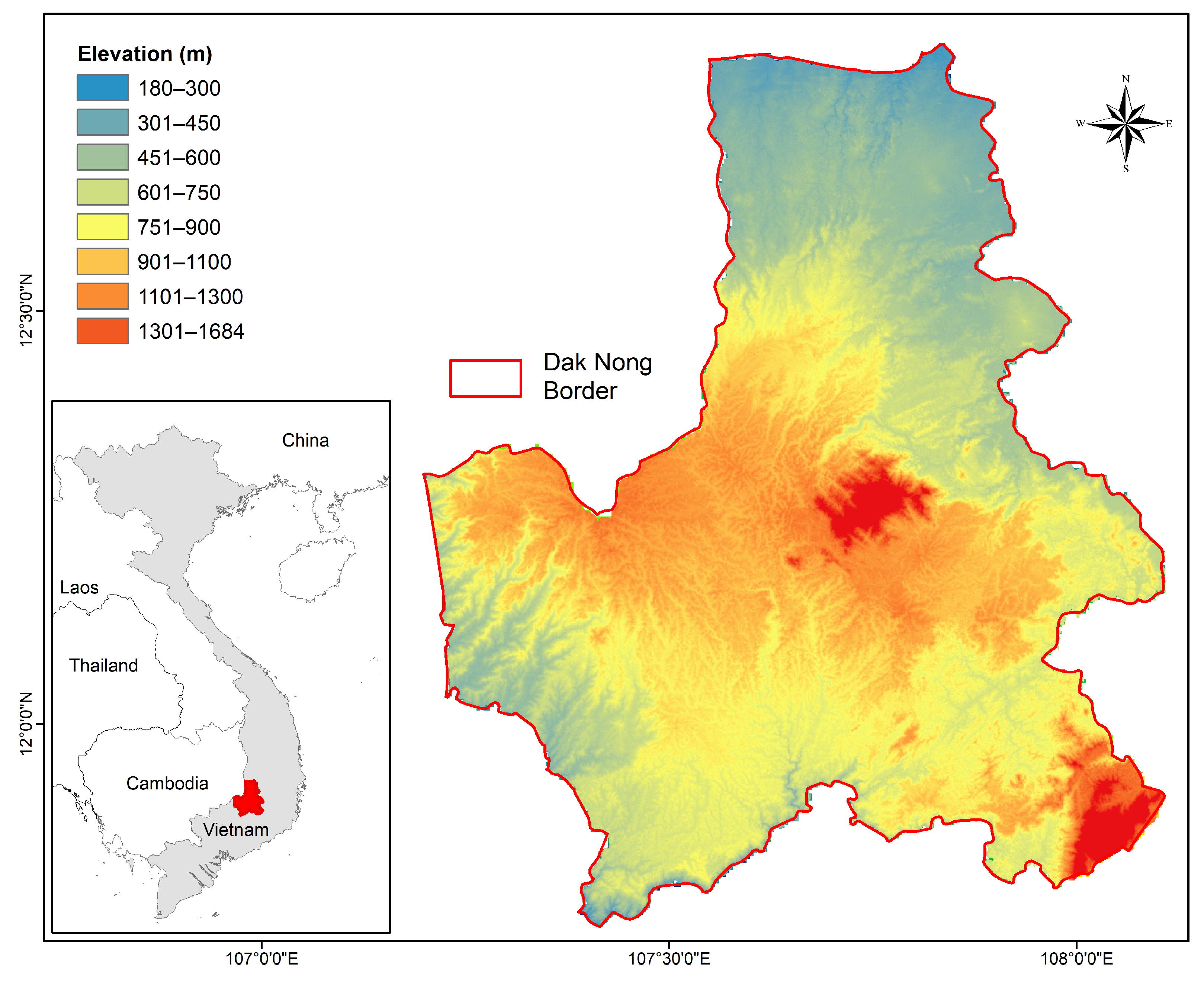
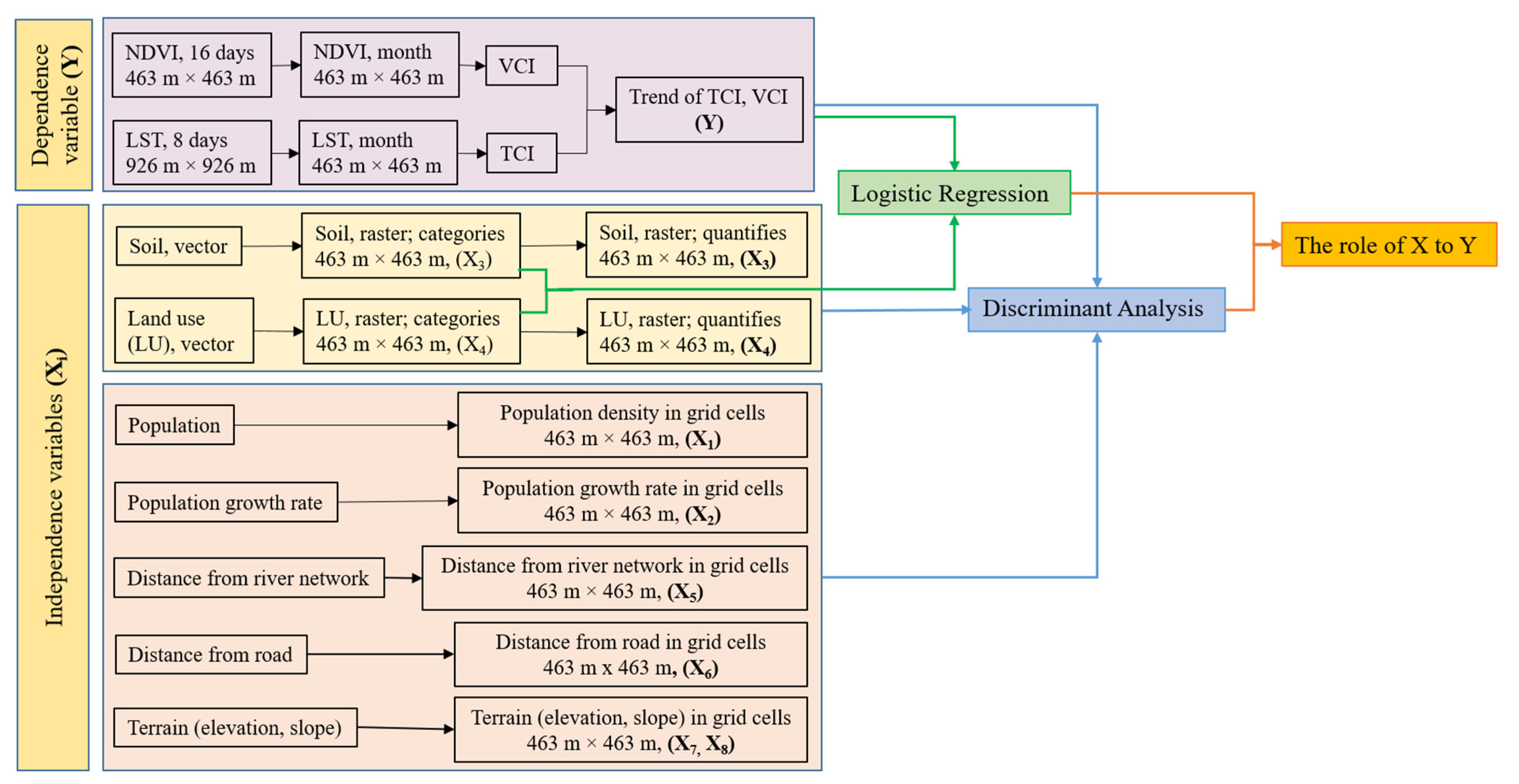

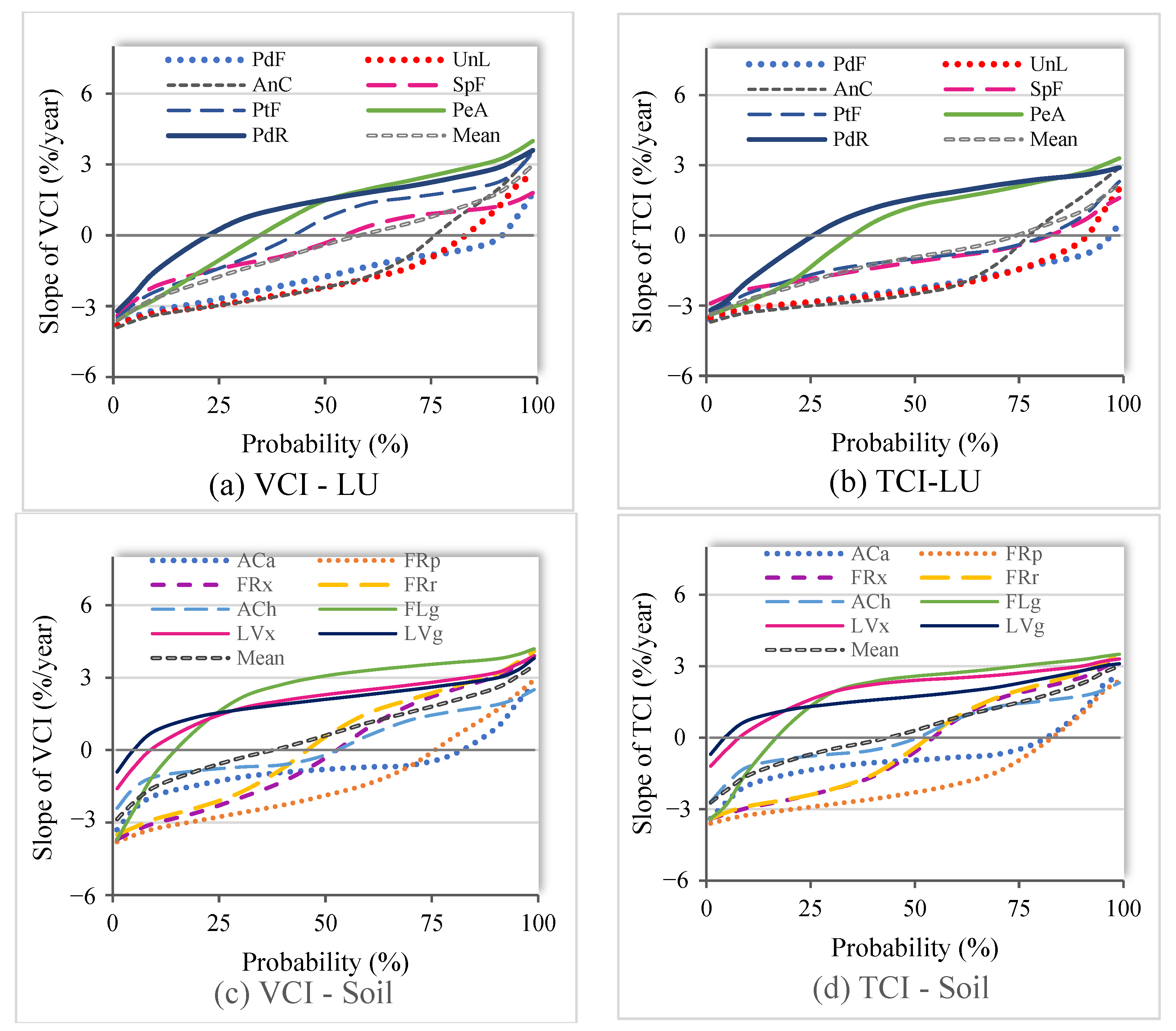
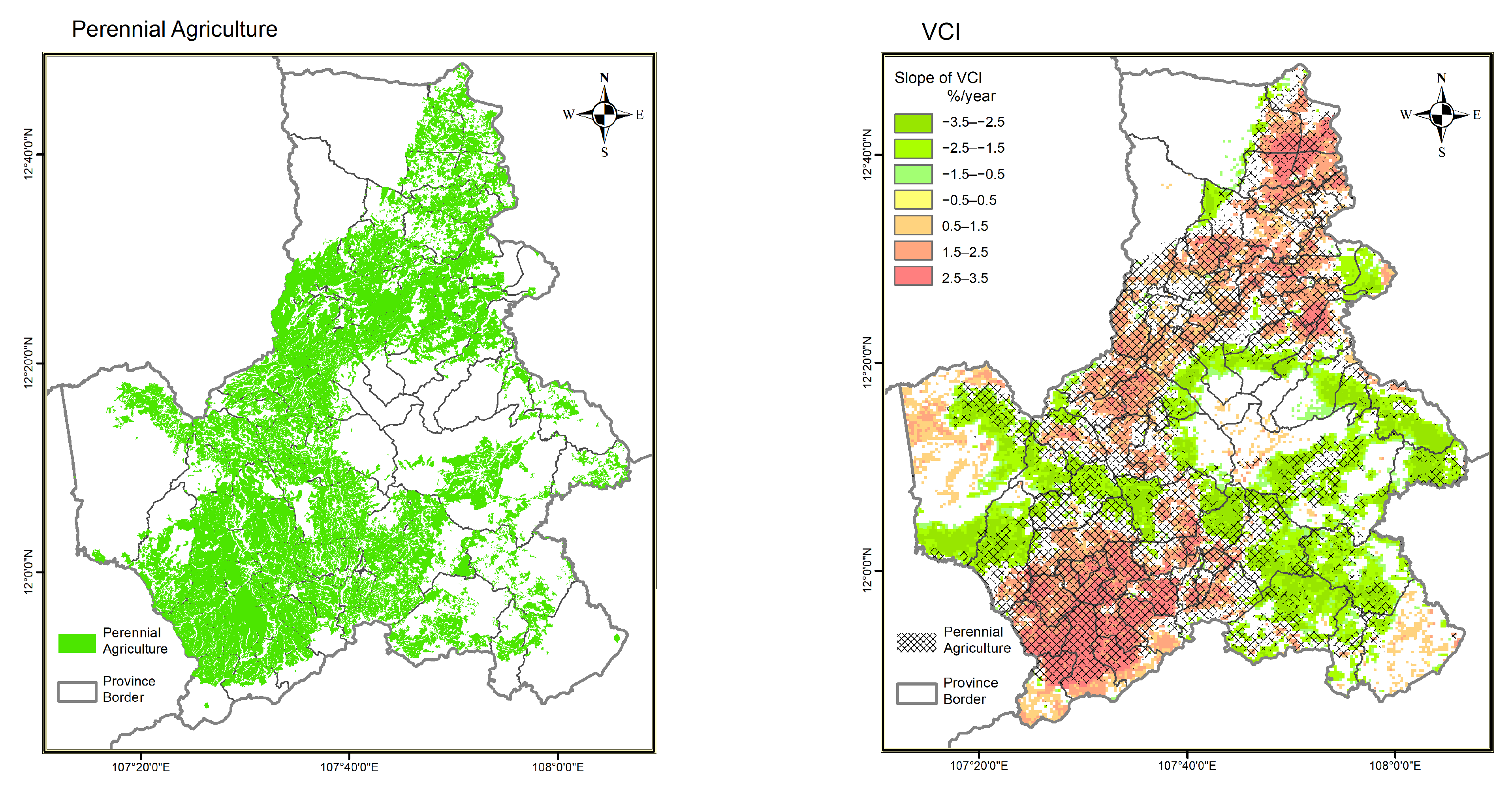
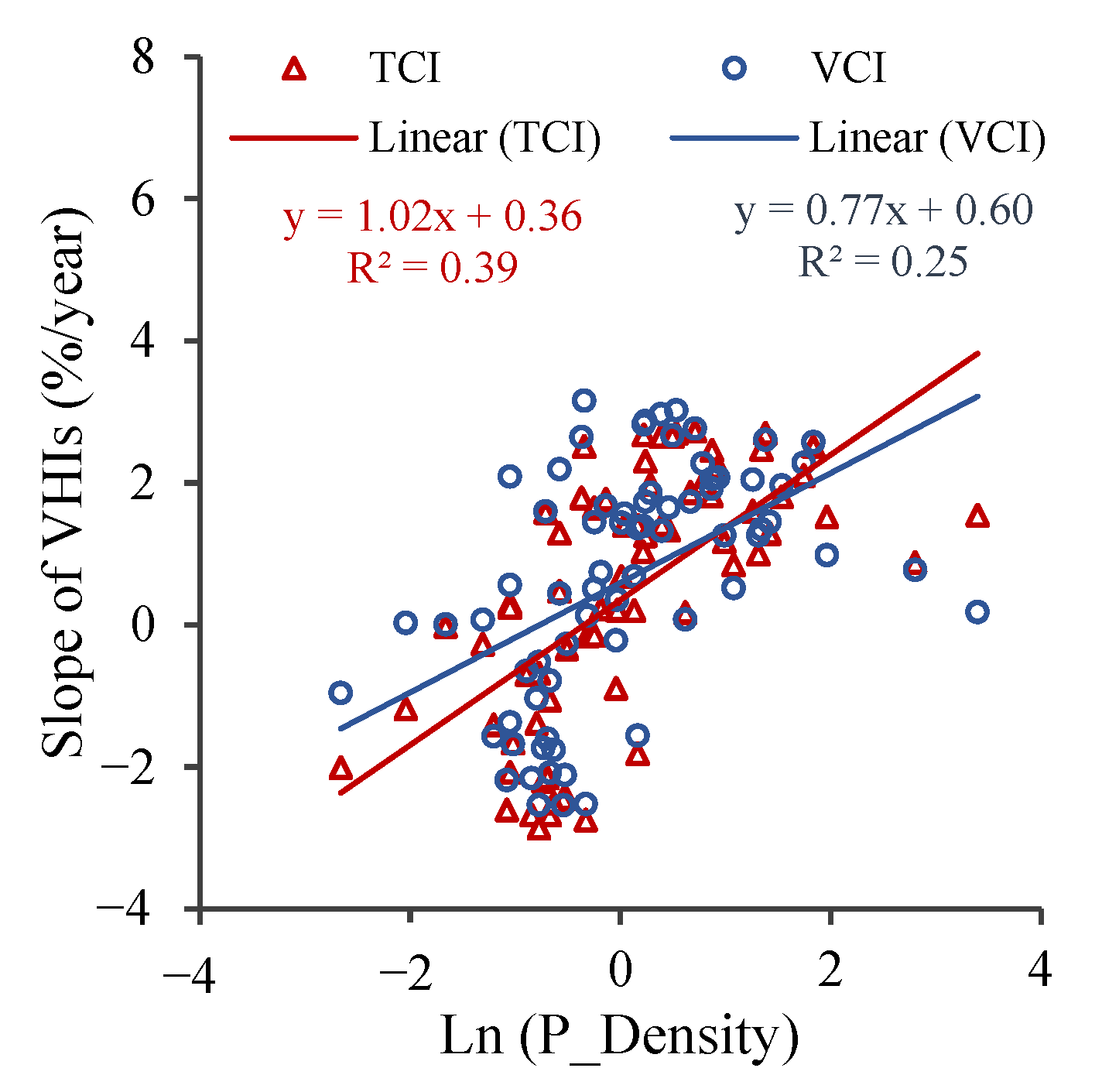
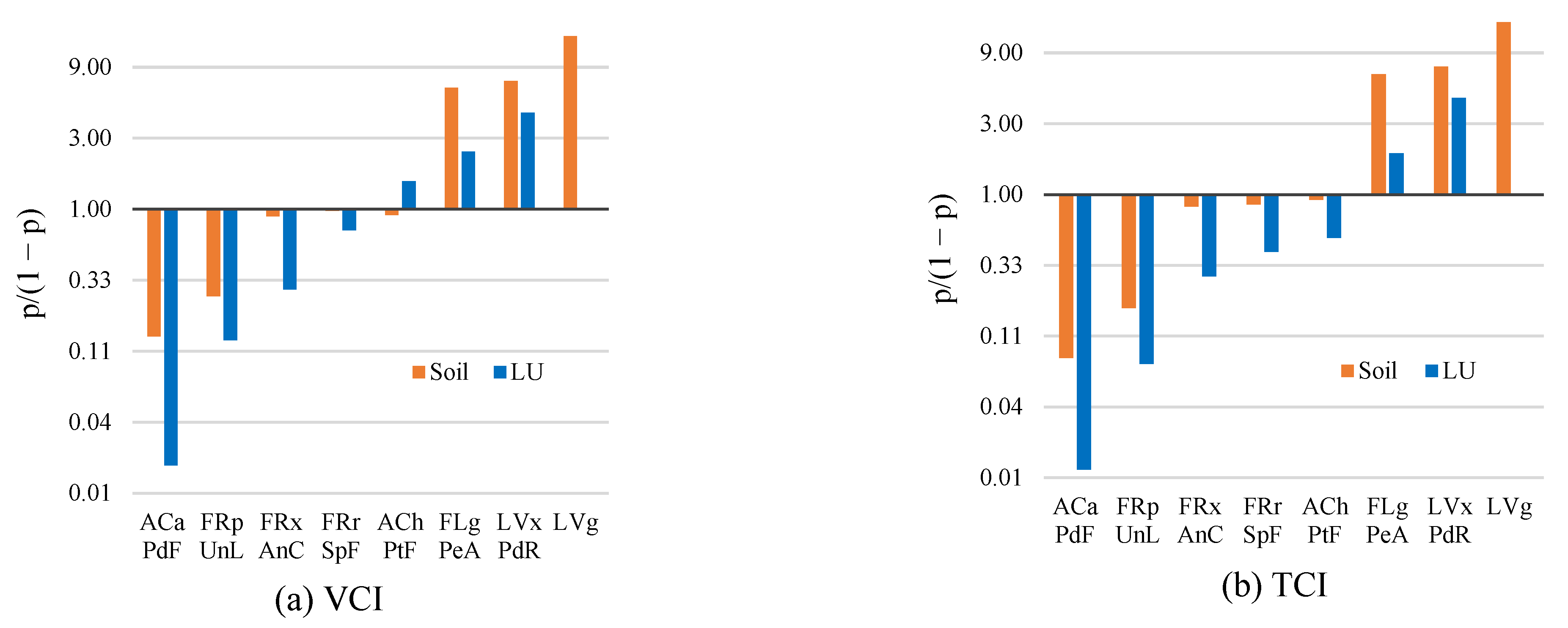

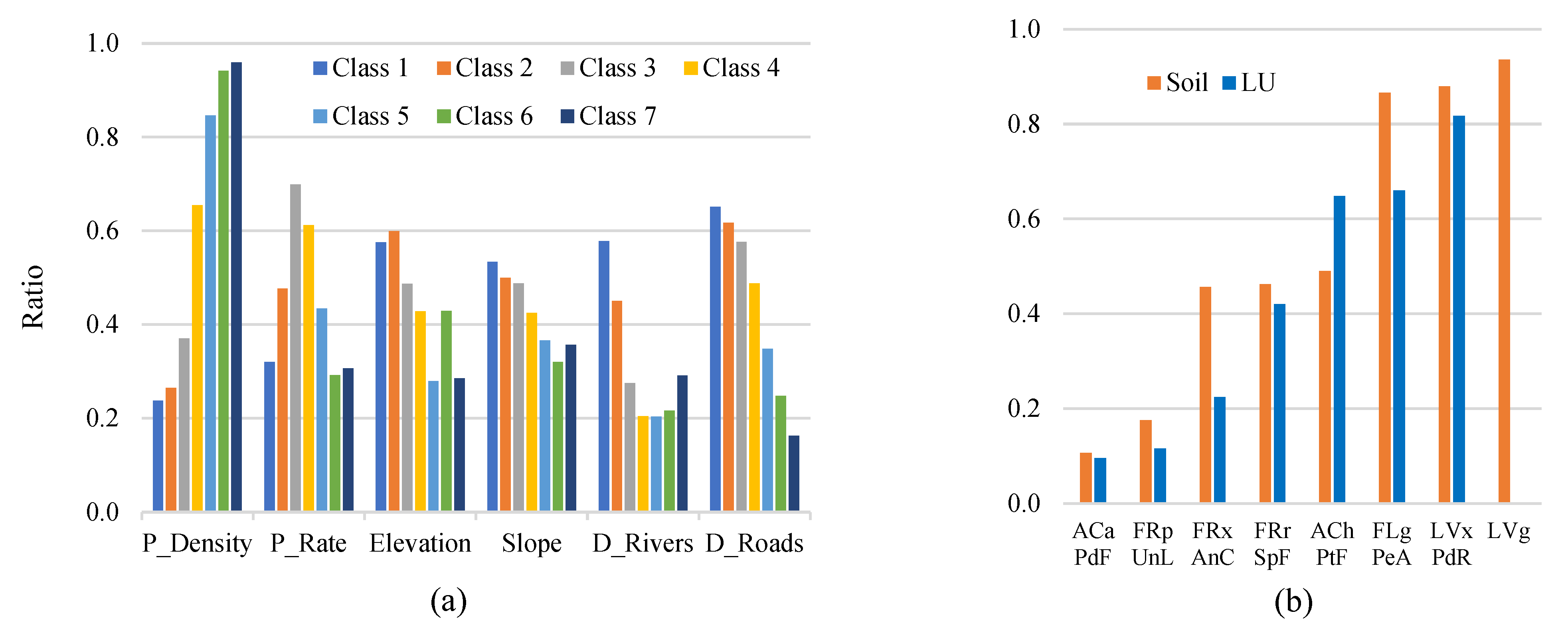
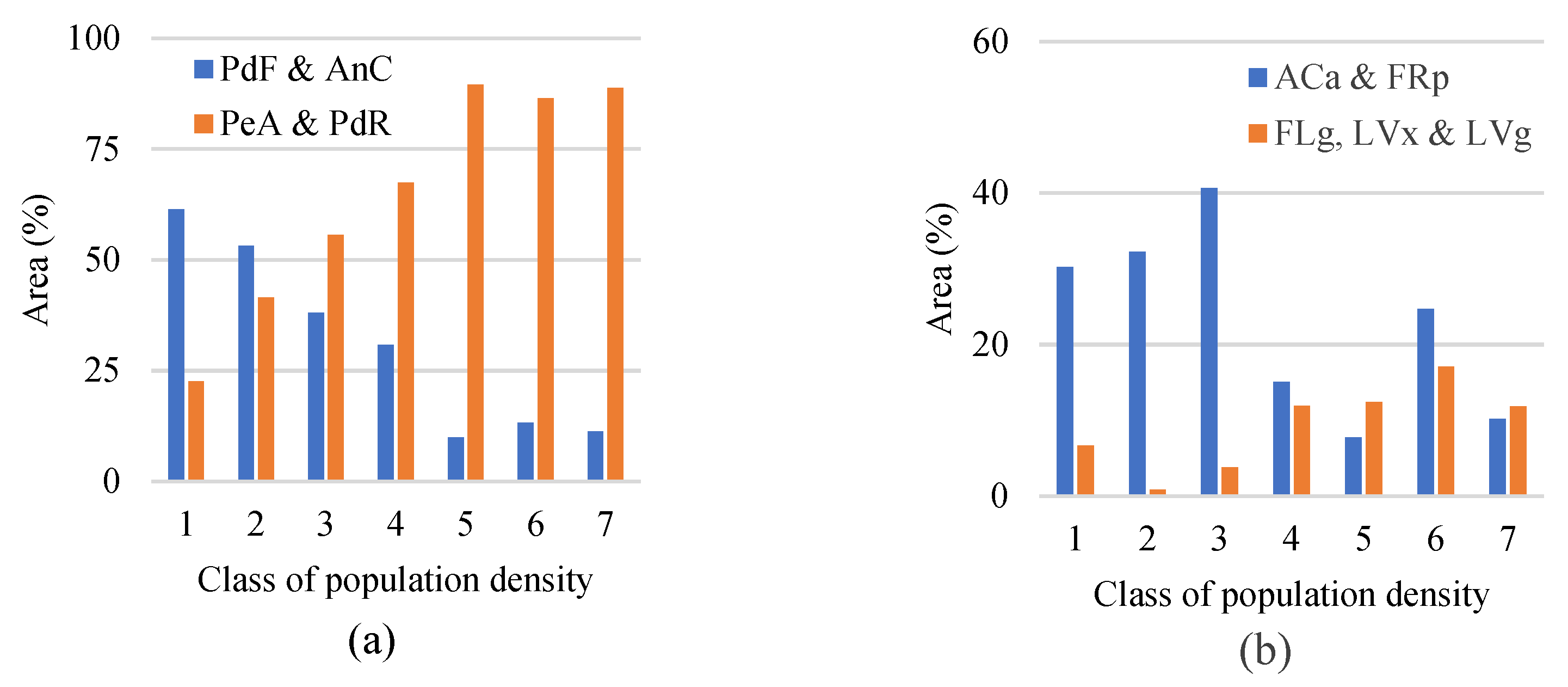
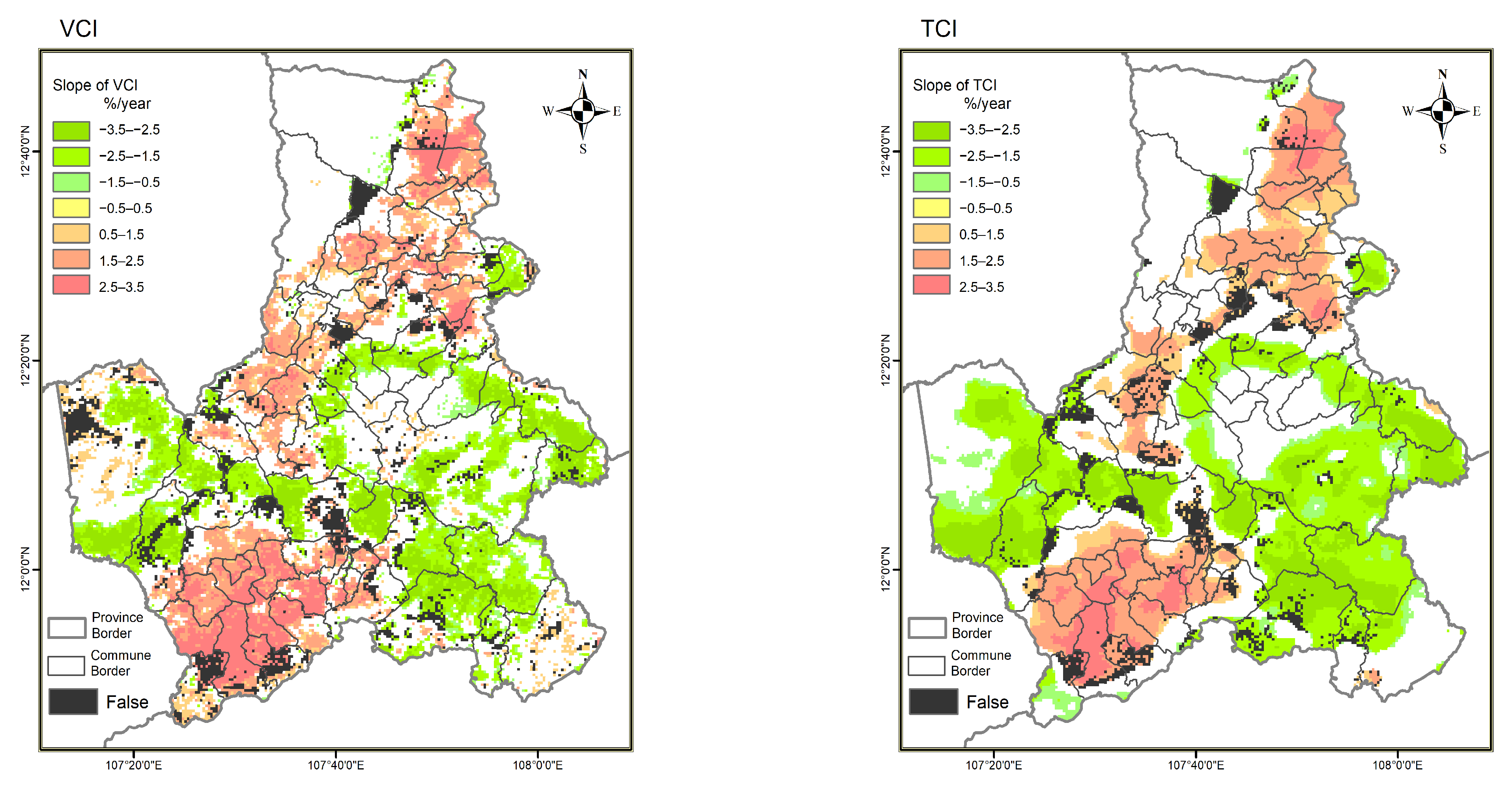

| Land Use Type | Symbol | Area (%) |
|---|---|---|
| Perennial Agriculture | PeA | 38.0 |
| Production Forest | 24.1 | |
| Annual Crops | AnC | 14.4 |
| Protection Forest | PtF | 5.6 |
| Special-use Forest | SpF | 5.0 |
| Unused Land | UnL | 1.1 |
| Paddy Rice | PdR | 0.7 |
| Soil Type | FAO Symbol | Area (%) |
|---|---|---|
| Rhodic Ferralsols | FRr | 41.7 |
| Plinthic Ferralsols | FRp | 22.0 |
| Xanthic Ferralsols | FRx | 8.3 |
| Haplic Arenosols | ACh | 3.2 |
| Chromic Luvisols | LVx | 3.2 |
| Arenic Acrisols | ACa | 3.0 |
| Gleyic Luvisols | LVg | 1.4 |
| Gleyic Fluvisols | FLg | 1.3 |
| The Independent Variable Is Land Use | The Independent Variable Is Soil | |||||
|---|---|---|---|---|---|---|
| Land Use Types | VCI | TCI | Soil Types | VCI | TCI | |
| Exp(b) | 0.07 | 0.05 | ACa | 0.09 | 0.07 | |
| UnL | 0.09 | 0.37 | FRp | 0.17 | 0.14 | |
| AnC | 0.18 | 0.76 | FRx | 0.51 | 0.60 | |
| SpF | 0.93 | 0.98 * | FRr | 0.59 | 0.61 | |
| PeA | 1.14 | 7.88 | ACh | 0.72 | 0.62 | |
| PdR | 3.75 | 29.63 | FLg | 5.28 | 5.81 | |
| LVg | 12.33 | 13.54 | ||||
| b0 | 0.528 | −1.470 | 0.463 | 0.369 | ||
| Correct (%) | 74.1 | 75.5 | 62.1 | 64.4 | ||
| P_Density (ng/ha) | D_Road (m) | D_River (m) | Slope (o) | ||
|---|---|---|---|---|---|
| Land use types | 0.3 | 2914 | 1075 | 2.4 | |
| UnL | 0.2 | 2483 | 675 | 2.4 | |
| AnC | 0.6 | 2008 | 508 | 2.2 | |
| PeA | 0.9 | 1148 | 240 | 1.8 | |
| PdR | 1.8 | 696 | 214 | 1.3 | |
| Soil types | ACa | 0.7 | 2017 | 645 | 1.3 |
| FRp | 0.6 | 2625 | 820 | 2.4 | |
| FLg | 1.0 | 1047 | 152 | 1.3 | |
| LVx | 1.6 | 781 | 276 | 1.2 | |
| LVg | 1.1 | 768 | 199 | 1.3 |
| P_Density (People/ha) | P_Rate (%/year) | Elevation (m) | Slope (Degree) | D_Rivers (m) | D_Roads (m) | Class |
|---|---|---|---|---|---|---|
| 0.1 | −5.5 | 200 | 0.0 | 0 | 0 | 1 2 3 4 5 6 7 |
| 0.3 | 0.6 | 400 | 0.8 | 250 | 250 | |
| 0.5 | 1.4 | 550 | 1.3 | 500 | 500 | |
| 0.8 | 1.9 | 650 | 1.8 | 1000 | 1000 | |
| 1.2 | 2.9 | 750 | 2.5 | 1500 | 1500 | |
| 1.8 | 4.6 | 850 | 3.5 | 2000 | 2500 | |
| 3.0 | 12.0 | 950 | 5.0 | 2500 | 4000 | |
| 30.0 | 14.0 | 1200 | 35.0 | 8000 | 13,000 |
| Standardized Canonical Discriminant Function Coefficients | Structure Matrix | ||||||
|---|---|---|---|---|---|---|---|
| Step 1 | Setp 2 | Step 3 | Step 1 | Step 2 | Step 3 | ||
| VCI | P_Density | 0.519 | 0.527 | 0.528 | 0.713 | 0.717 | 0.718 |
| LU | 0.517 | 0.515 | 0.519 | 0.650 | 0.654 | 0.654 | |
| Soil | 0.347 | 0.341 | 0.343 | 0.436 | 0.439 | 0.439 | |
| P_Rate | 0.181 | 0.236 | 0.237 | 0.397 | 0.400 | 0.400 | |
| D_Roads | 0.118 | 0.112 | 0.115 | 0.354 | 0.356 | 0.357 | |
| D_Rivers | 0.017 | 0.018 | 0.340 | 0.342 | |||
| Elevation | 0.128 | 0.187 | |||||
| Slope | 0.018 | 0.159 | |||||
| TCI | P_Density | 0.564 | 0.577 | 0.700 | 0.713 | ||
| LU | 0.447 | 0.445 | 0.552 | 0.562 | |||
| Soil | 0.293 | 0.295 | 0.388 | 0.395 | |||
| P_Rate | 0.218 | 0.291 | 0.363 | 0.369 | |||
| D_Roads | 0.174 | 0.178 | 0.356 | 0.362 | |||
| D_Rivers | 0.155 | 0.156 | 0.353 | 0.359 | |||
| Elevation | 0.172 | 0.193 | |||||
| Slope | 0.104 | 0.182 | |||||
| VCI | TCI | |
|---|---|---|
| P_Density | 2.377 | 2.719 |
| LU | 2.220 | 2.275 |
| Soil | 2.021 | 2.029 |
| P_Rate | 1.822 | 1.969 |
| D_Roads | 0.728 | 1.161 |
| D_Rivers | 1.155 | |
| (Constant) | −4.026 | −4.862 |
| Correct (%) | 82.3 | 85.8 |
Disclaimer/Publisher’s Note: The statements, opinions and data contained in all publications are solely those of the individual author(s) and contributor(s) and not of MDPI and/or the editor(s). MDPI and/or the editor(s) disclaim responsibility for any injury to people or property resulting from any ideas, methods, instructions or products referred to in the content. |
© 2023 by the authors. Licensee MDPI, Basel, Switzerland. This article is an open access article distributed under the terms and conditions of the Creative Commons Attribution (CC BY) license (https://creativecommons.org/licenses/by/4.0/).
Share and Cite
Hiep, N.V.; Thao, N.T.T.; Viet, L.V.; Luc, H.C.; Ba, L.H. Affecting of Nature and Human Activities on the Trend of Vegetation Health Indices in Dak Nong Province, Vietnam. Sustainability 2023, 15, 5695. https://doi.org/10.3390/su15075695
Hiep NV, Thao NTT, Viet LV, Luc HC, Ba LH. Affecting of Nature and Human Activities on the Trend of Vegetation Health Indices in Dak Nong Province, Vietnam. Sustainability. 2023; 15(7):5695. https://doi.org/10.3390/su15075695
Chicago/Turabian StyleHiep, Nguyen Van, Nguyen Thi Thanh Thao, Luong Van Viet, Huynh Cong Luc, and Le Huy Ba. 2023. "Affecting of Nature and Human Activities on the Trend of Vegetation Health Indices in Dak Nong Province, Vietnam" Sustainability 15, no. 7: 5695. https://doi.org/10.3390/su15075695
APA StyleHiep, N. V., Thao, N. T. T., Viet, L. V., Luc, H. C., & Ba, L. H. (2023). Affecting of Nature and Human Activities on the Trend of Vegetation Health Indices in Dak Nong Province, Vietnam. Sustainability, 15(7), 5695. https://doi.org/10.3390/su15075695










